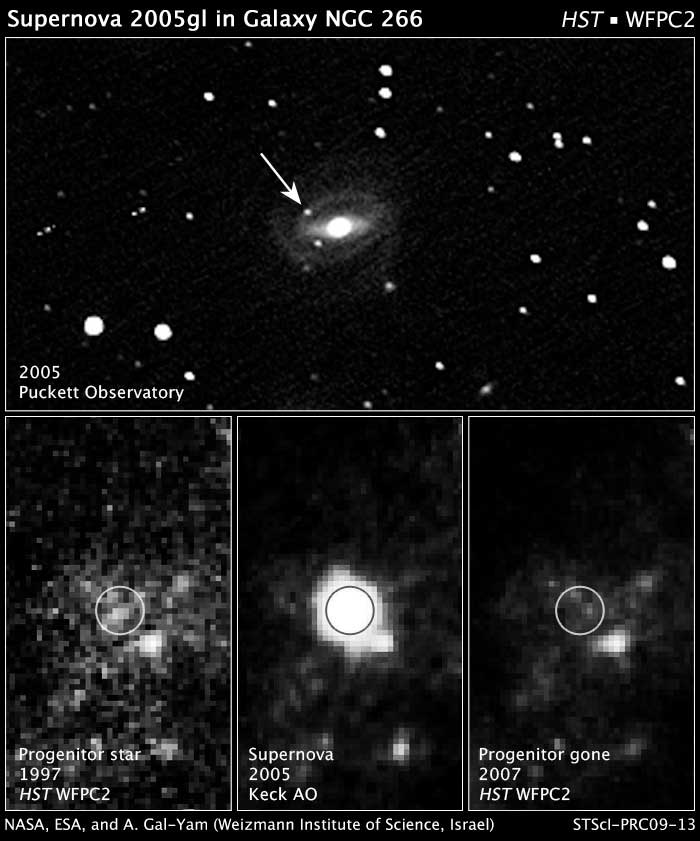Star Explodes, and So Might Theory

A massive star a million times brighter than our sun exploded way too early in its life, suggesting scientists don't understand stellar evolution as well as they thought.
"This might mean that we are fundamentally wrong about the evolution of massive stars, and that theories need revising," said Avishay Gal-Yam of the Weizmann Institute of Science in Rehovot, Israel.
According to theory, the doomed star, about 100 times our sun's mass, was not mature enough to have evolved a massive iron core of nuclear fusion ash, considered a prerequisite for a core implosion that triggers the sort of supernova blast that was seen.
The new study involves old images that have just been compared. It is one of the rare instances where the progenitor of an exploded star has been found.
The explosion, called supernova SN 2005gl, was seen at a distance of 215 million light-years in the barred-spiral galaxy NGC 266 on Oct. 5, 2005. Pictures from the Hubble Space Telescope archive, taken in 1997, reveal the star, pre-explosion, as a very luminous one.
The progenitor had been proposed previously, but now has been firmly identified, according to a study published Sunday in the online version of the journal Nature.
The progenitor star was so bright that it probably belonged to a class of stars called Luminous Blue Variables (LBVs), "because no other type of star is as intrinsically brilliant," Gal-Yam said. As an LBV-class star evolves it sheds much of its mass through a violent stellar wind. Only at that point does it develop a large iron core, then the core collapses in an explosion.
Breaking space news, the latest updates on rocket launches, skywatching events and more!
The unexpected explosion could mean other stars may behave in ways not previously expected, including one relatively close to home, known as Eta Carinae, just 7,500 light-years away and in our own Milky Way galaxy. Extremely massive and luminous stars topping 100 solar masses, such as Eta Carinae, are expected to lose their entire hydrogen envelopes prior to their ultimate explosions as supernovae.
"These observations demonstrate that many details in the evolution and fate of LBVs remain a mystery," said Mario Livio of the Space Telescope Science Institute in Baltimore. "We should continue to keep an eye on Eta Carinae, it may surprise us yet again,"
"The progenitor identification shows that, at least in some cases, massive stars explode before losing most of their hydrogen envelope, suggesting that the evolution of the core and the evolution of the envelope are less coupled than previously thought, a finding which may require a revision of stellar evolution theory," said study co-author Douglas Leonard from San Diego State University.
One possibility is that the progenitor to SN 2005gl was really a pair of stars, a binary system that merged. This would have stoked nuclear reactions to brighten the star enormously, making it look more luminous and less evolved than it really is.
"This also leaves open the question that there may be other mechanisms for triggering supernova explosions," says Gal-Yam. "We may be missing something very basic in understanding how a superluminous star goes through mass loss."
Gal-Yam reports that the observation revealed that only a small part of the star's mass was flung off in the explosion. Most of the material, says Gal-Yam, was drawn into the collapsing core that has probably become a black hole estimated to be at least 10 to 15 solar masses.
- Video: Supernova Destroyer/Creator
- Supernova Birth Observed for First Time
- Top 10 Star Mysteries

Space.com is the premier source of space exploration, innovation and astronomy news, chronicling (and celebrating) humanity's ongoing expansion across the final frontier. Originally founded in 1999, Space.com is, and always has been, the passion of writers and editors who are space fans and also trained journalists. Our current news team consists of Editor-in-Chief Tariq Malik; Editor Hanneke Weitering, Senior Space Writer Mike Wall; Senior Writer Meghan Bartels; Senior Writer Chelsea Gohd, Senior Writer Tereza Pultarova and Staff Writer Alexander Cox, focusing on e-commerce. Senior Producer Steve Spaleta oversees our space videos, with Diana Whitcroft as our Social Media Editor.
